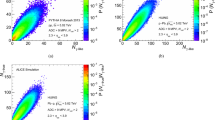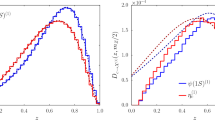Abstract
The dependence of the q and T parameters of the Tsallis-distribution-shaped fragmentation function (FF) on the fragmentation scale (found to be equal to the jet mass) is calculated via the resummation of the branching process of jet fragmentation in the leading-log appriximation (LLA) in the \(\phi ^3\) theory. Jet and hadron spectra in electron-positron (\(e^+e^-\)) annihilations with 2- and 3-jet final states are calculated using virtual leading partons. It is found that jets, produced earlier in the branching process, are more energetic, and the energy, angle and multiplicity distributions of hadrons stemming from them are broader. It is also found that replacing the LL resummation in the branching process by a single splitting provides good approximation for the jet energy distribution in 2-jet events. Furthermore, a micro-canonical statistical event generator is presented for the event-by-event calculation of hadron momenta in \(e^+e^-\) annihilations.










Similar content being viewed by others
Data Availability
This manuscript has no associated data or the data will not be deposited. [Authors’ comment: This is a theoretical study and no experimental data.]
References
C. Bignamini, F. Becattini, F. Piccinini, Eur. Phys. J. C 72, 2176 (2012)
I. Bediaga, E.M.F. Curado, J. Miranda, Phys. A 286, 156 (2000)
C. Beck, Eur. Phys. J. A 40, 267–273 (2009)
G. Wilk, Z. Wlodarczyk, Eur. Phys. J. A 40, 299–312 (2009)
K. Urmossy, G.G. Barnafoldi, T.S. Biro, Phys. Lett. B 701, 111 (2011)
K. Urmossy, G.G. Barnafldi, T.S. Biro, Phys. Lett. B 718, 125 (2012)
K. Urmossy, Z. Xu, PoS DIS2016, 054, (2016) arXiv:1605.06876
V.V. Begun, M. Gazdzicki, M.I. Gorenstein, Acta Phys. Polon. B 43, 1713 (2012)
V.V. Begun, M. Gazdzicki, M.I. Gorenstein, Phys. Rev. C 80, 064903 (2009)
V.V. Begun, M. Gazdzicki, M.I. Gorenstein, Phys. Rev. C 78, 024904 (2008)
Q. Wang, F.H. Liu, K.K. Olimov, Adv. High Energy Phys. 2021, 6677885 (2021)
K. Urmossy, Eur. Phys. J. A 53, 36 (2017). arXiv:1606.03208
T.A. Trainor, arXiv:2107.10899
Z. Wlodarczyk, M. Rybczynski, New J. Phys. 22, 113002 (2020)
G. Biro et al., AIP Conf. Proc. 1853(1), 080001 (2017)
G. Biro et al., Entropy 19, 88 (2017). arXiv:1702.02842
A.S. Parvan, Eur. Phys. J. A 52, 355 (2016)
J. Cleymans, G.I. Lykasov, A.S. Parvan et al., Phys. Lett. B 723, 351–354 (2013)
L. Marques, J. Cleymans, A. Deppman, Phys. Rev. D 91, 054025 (2015)
I. Sena, A. Deppman, Eur. Phys. J. A 49, 17 (2013)
M. Waqas, G.X. Peng, F.H. Liu et al., Eur. Phys. J. Plus 137, 9, 1041 (2022)
J.B. Gu, C.Y. Li, Q. Wang et al., J. Phys. G Nucl. Part. Phys. 49, 115101 (2022)
T. Bhattacharyya, J. Cleymans, A. Khuntia et al., Eur. Phys. J. A 52, 2, 30 (2016). arXiv:1507.08434
K. Jiang, Y. Zhu, W. Liu et al., Phys. Rev. C 91, 2, 024910 (2015)
P.P. Yang, M.Y. Duan, F.H. Liu et al., Symmetry 2022 14, 1530 (2022)
Y. Su, X.L. Chen, Y.J. Sun et al., Nucl. Sci. Tech. 32, 108 (2021)
X.H. Zhang, F.H. Liu, K.K. Olimov, Int. J. Mod. Phys. E 30, 2150051 (2021)
P.P. Yang, M.Y. Duan, F.H. Liu, Eur. Phys. J. A 57, 2, 63 (2021)
S. Sharma, G. Chaudhary, K. Sandeep et al., Int. J. Mod. Phys. E 29, 04, 2050021 (2020)
B. De, G. Sau, S.K. Biswas et al., Int. J. Mod. Phys. A 25, 1239 (2010). arXiv:0911.1040
L. Liu, Z.B. Yin, L. Zheng, Chin. Phys. C 47(2), 024103 (2023)
G.R. Che, J.B. Gu, W.C. Zhang et al., J. Phys. G: Nucl. Part. Phys. 48, 095103 (2021)
J.Q. Tao, M. Wang, H. Zheng, A. Bonasera et al., J. Phys. G: Nucl. Part. Phys. 48, 105102 (2021)
Z. Tang, Y. Xu, L. Ruan et al., Phys. Rev. C 79, 051901 (2009). arXiv:0812.1609
J.Q. Tao, W.H. Wu, M. Wang et al., MDPI Particles 2022 5, 146 (2022)
L.L. Li, F.H. Liu, M. Waqas et al., Universe 8, 1, 31 (2022)
R.N. Patra, B. Mohanty, T.K. Nayak, Eur. Phys. J. Plus 136, 6, 702 (2021)
X.H. Zhang, Y.Q. Gao, F.H. Liu et al., Adv. High Energy Phys. 2022, 7499093 (2022)
M. Waqas, G.X. Peng, F.H. Liu et al., Eur. Phys. J. Plus 137, 9, 1026 (2022)
X.H. Zhang, F.H. Liu, K.K. Olimov et al., Adv. High Energy Phys. 2022, 5949610 (2022)
J. Chen, J. Deng, Z. Tang et al., Phys. Rev. C 104, 034901 (2021)
M. Waqas, G.X. Peng, R.Q. Wang et al., Eur. Phys. J. Plus 136, 10, 1082 (2021)
M. Waqas, G.X. Peng, F.H. Liu, J. Phys. G 48, 7, 075108 (2021)
M. Shao, L. Yi, Z. Tang et al., J. Phys. G 37, 085104 (2010). arXiv:0912.0993
K. Urmossy, T.S. Biro, Phys. Lett. B 689, 14 (2010). arXiv:0911.1411
L.L. Li, F.H. Liu, K.K. Olimov, Entropy 23, 478 (2021)
Q. Wang, F.H. Liu, Adv. High Energy Phys. 2020, 5031494 (2020)
M. Waqas, F.H. Liu, R.Q. Wang et al., Eur. Phys. J. A 56, 7, 188 (2020)
L. Qiao, G. Che, J. Gu et al., J. Phys. G: Nucl. Part. Phys. 47, 075101 (2020)
K. Urmossy, G. G. Barnafoldi, S. Harangozo et al., J. Phys. Conf. Ser. 805, (2017) 1, 012010, arXiv:1501.02352
K. Urmossy, T.S. Biro, G.G. Barnafoldi et al., Proc. WPCF 2014, arXiv:1501.05959, arXiv:1405.3963
T.S. Biro, G.G. Barnafoldi, P. Van et al., arXiv:1404.1256 (2014)
Z. Tang, L. Yi, L. Ruan et al., Chin. Phys. Lett. 30, 031201 (2013). arXiv:1101.1912
Q. Zhang, Y.Q. Gao, F.H. Liu et al., Ann. Phys. 534, 2100567 (2022)
L.N. Gao, E.Q. Wang, Adv. High Energy Phys. 2021, 6660669 (2021)
Y.M. Tai, P.P. Yang, F.H. Liu, Adv. High Energy Phys. 2021, 8832892 (2021)
X.H. Zhang, F.H. Liu, Adv. High Energy Phys. 2021, 9548737 (2021)
A. Saha, S. Sanyal, Mod. Phys. Lett. A 36(22), 2150152 (2021)
G.S. Pradhan, D. Sahu, S. Deb et al., arXiv:2106.14297
M. Ishihara, arXiv:2104.11427
J.D. Castano-Yepes, F.M. Paniagua, V. Munoz-Vitelly et al., Phys. Rev. D 106, 11, 116019 (2022)
E. Andrade, A. Deppman, E. Megias et al., Phys. Rev. D 101, 054022 (2020)
P.H.G. Cardoso, T.N. da Silva, A. Deppman et al., Eur. Phys. J. A 53, 191 (2017)
E. Megias, M.J. Teixeira, V.S. Timoteo et al., arXiv:2203.11080
Y.P. Zhao, Phys. Rev. D 101, 096006 (2020)
J. Rozynek, G. Wilk, Eur. Phys. J. A 52, 1, 13 (2016)
T.S. Biro, A. Jakovac, Phys. Rev. Lett. 94, 132302 (2005)
A. Deppman, A.K. Golmankhaneh, E. Megias, R. Pasechnik, Phys. Lett. B 839, 137752 (2023)
C.Y. Wong, G. Wilk, Phys. Rev. D 87, 114007 (2013)
A. Deppman, E. Megias, D.P. Menezes, MDPI Phys. 2(3), 455–480 (2020)
A. Deppman, E. Megias, D.P. Menezes, Phys. Rev. D 101, 034019 (2020). (also for Referee 2)
A. Deppman, E. Megias, D.P. Menezes et al., Entropy 20(9), 633 (2018)
A. Deppman, Phys. Rev. D 93, 054001 (2016)
Y.L. Dokshitzer, Sov. Phys. JETP 46, 641 (1977)
V. Gribov, L. Lipatov, Sov. J. Nucl. Phys. 15, 438 (1972)
G. Altarelli, G. Parisi, Nucl. Phys. B 126, 298 (1977)
M. Grazzini, Nucl. Phys. B 518, 303–315 (1998)
Y. Kazama, Y.P. Yao, Phys. Rev. D 19, 3111 (1979)
Y. Kazama, Y.P. Yao, Phys. Rev. D 19, 3121 (1979)
I. Feige, M.D. Schwartz, Phys. Rev. D 90, 105020 (2014). arXiv:1403.6472
J.C. Collins, T.C. Rogers, A.M. Stasto, Phys. Rev. D 77, 085009 (2008). arXiv:0708.2833
J. Collins, Phys. Rev. D 65, 094016 (2002). (hep-ph/0110113)
R. Perez-Ramos, D. Denterria, JHEP 08, 068 (2014)
OPAL Collab., Eur. Phys. J. C 40, 287–316 (2005)
ALEPH Collab., Eur. Phys. J. C 35, 457–486 (2004)
ATLAS Collab., JHEP 1205, 128 (2012)
ATLAS Collab., Phys. Rev. D 84, 054001 (2011)
Author information
Authors and Affiliations
Corresponding author
Additional information
Communicated by Tamas Biro.
Appendices
6 Appendix
A Phasespace of n massless particles
where the Fourier-transform of the single-particle phasespace \(\varphi (s)\) can be evaluated in the frame, in which, \(s = (\sigma ,{\textbf{0}})\) (with \(\sigma ^2 = s_0^2 - \textbf{s}^2\)), and \(p = (p,{\textbf{p}})\):
We may evaluate the inverse Fourier-transform in Eq. (1) in the frame, where \(P = (M_0,{\textbf{0}})\), thus,
As we have poles at \(s_0 = \pm |{\textbf{s}}|\), we use Cauchy’s formula \(\oint \frac{dzf(z)}{(z-z_0)^n}\sim f^{(n-1)}(z_0)\), and arrive at terms of the form of
The actual values of the constant factors \(A^{\pm }_j\) multiplying the terms coming from the poles at \(s_0 = \pm |{\textbf{s}}|\), are of no importance from the point of view of the particle distributions.
B Calculation of the splitting function
Via introducing the renormalized field and coupling \(g=Z_g g_r\) and \(\phi = Z_3^{1/2} \phi _r \), along with \(Z_3 = 1 + \delta Z_3\) and \(Z_g = 1 + \delta Z_g\), we arrive at the renormalised Lagrangian
As \(\delta Z_3\) and \(\delta Z_g\) are of \(\mathcal {O}(g^2)\), terms proportional to them come as perturbative corrections. This way, a propagator of momentum p is \(i/(p^2+i\epsilon )\), a vertex is \(-ig_r\), the counter terms are \(ip^2\delta Z_3\) and \(-ig_r(\delta Z_g+ \frac{3}{2}\delta Z_3)\), and a cut propagator is \(2\pi \delta (p^2)\). Propagators and vertices on the right of the cuts are complex conjugates.
We may write \(A(z,P^2) = \delta (1-z)A_1(z,P^2) + A_2(z,P^2)\) in Eq. (12). When calculating \(A_1(z,P^2)\), we use the identity
\(\prod \nolimits _i \dfrac{1}{A_i^{\alpha _i}} = \dfrac{\varGamma (\alpha )}{\prod \nolimits _i \varGamma (\alpha _i)} \prod \nolimits _i\int \nolimits _0^1 \dfrac{d\xi _i\,\xi _i^{\alpha _i-1} \delta (1-\alpha )}{(\sum \xi _i A_i)^\alpha }\), with \(\alpha = \sum \alpha _i\), thus,
Substituting \({\tilde{q}}=q - \xi _1k-\xi _2P\) and \(L_1 = -P^2\xi _2(1-\xi _2)\) in the first term, \({\tilde{q}} = q-\xi _1k\) in the second term and \({\tilde{q}} = q-\xi _1(P-k)\) in the third term, we get
Substituting \({\tilde{q}} = (iq_E,{\textbf{q}}_E)\) (Wick-rotation) gives
Using \(\int \limits _0^\infty \dfrac{dx\,x^{a-1}}{(x+1)^{a+b}} = \varGamma (a)\varGamma (b)/\varGamma (a+b)\), \(\varGamma (\epsilon ) = 1/\epsilon -\gamma _E\) and setting \(D=6-2\epsilon \) along with \(g\rightarrow g\mu ^\epsilon \), we obtain
If we remove the divergences along with the \(P^2\) and \(\mu \) independent constants by the counter terms, we are left with
For the calculation of the second line of \(A(z,P^2)\) in Eq. (12), we parametrize momenta as \(P=(M,0,{\textbf{0}})\), \(k=(Mz/2,Mz/2,{\textbf{0}})\) and \(q=\alpha P + \beta k + q_T = (\alpha M + \beta Mz/2,\beta Mz/2,{\textbf{q}}_T)\). This way, the integration measure becomes \(d^Dq = (M^2z/2)d\alpha \, d\beta \, d^{D-2}{\textbf{q}}_T\). Besides, \(2Pq = M^2(2\alpha + \beta z)\), \(2 k q = M^2\alpha z\) and \(q^2 = M^2\alpha (\alpha +\beta z)-{\textbf{q}}_T^2\). Furthermore, due to the \(\delta \left[ (q-k)^2\right] \) term, \(q^2 = 2k q = M^2\alpha z\). This way, the second line of Eq. (12) becomes
Using the integral for \(\beta \) to eliminate the second \(\delta \) function gives
Using the identity \(\int \limits _0^1 d\alpha \alpha ^{a-1}(1-\alpha )^{b-1} = \varGamma (a)\varGamma (b)/\varGamma (a+b)\) and \(D=6-2\epsilon \) dimensions, where the coupling acquires dimension \(g\rightarrow g\mu ^\epsilon \), the solid angle is \(\kappa _D = 2\pi ^{D/2}/\varGamma (D/2)\) and \(\varGamma (-\epsilon )=-1/\epsilon -\gamma _E\), we obtain
We made use of \(\varGamma (-1+\epsilon )=-1/\epsilon +\gamma _E-1\), \(\varGamma (-\epsilon )=-1/\epsilon -\gamma _E\). Note that the \(1/\epsilon \) term being the collinear divergence, cannot be eliminated via renormalisation, however, it drops out of the splitting function, which is
Rights and permissions
Springer Nature or its licensor (e.g. a society or other partner) holds exclusive rights to this article under a publishing agreement with the author(s) or other rightsholder(s); author self-archiving of the accepted manuscript version of this article is solely governed by the terms of such publishing agreement and applicable law.
About this article
Cite this article
Urmossy, K., Jakovac, A. Scale dependence of the q and T parameters of the Tsallis distribution in the process of jet fragmentation. Eur. Phys. J. A 59, 122 (2023). https://doi.org/10.1140/epja/s10050-023-01041-4
Received:
Accepted:
Published:
DOI: https://doi.org/10.1140/epja/s10050-023-01041-4




